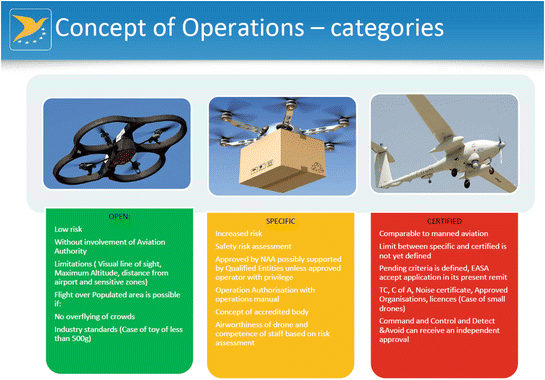As I said previously, the rules that apply are determined by which category you fall into, so the aim of this post is to help work out which drones/operations fall into which.
Open Category
An off the shelf drone in an safe area may fall in the “Open” category
My current feeling is that this is the most well defined, documented and understood category. I also think this is where the majority of hobbyists and even some commercials (by today’s standards) will operate. Essentially if your drone and operation are compliant with the following then you fall into the Open Category:
Drone design is Compliant with the Delegated Regulation, Privately Built, or Placed on Market < 1 July 2022
< 25kg Maximum Take Off Mass
Remain a safe distance from people and do not overfly assemblies
VLOS (*caveat for follow-me or observer usage)
< 120m / 400ft Height (**caveat for obstacles and Model Gliders)
Not carrying dangerous goods or dropping materials
No autonomous flight
To expand on some of the Caveats.:
* for certain aircraft and operations in the Open Category the regulations allow flight of up to 50m from the Remote Pilot in “Follow-Me” mode OR when having an Observer situated alongside the Remote Pilot you may delegate VLOS to the observer so you can focus on the camera view.
** for flights within 15m of an obstacle you may fly higher than 400ft if you have permission from the owner of the obstacle and remain within 15m of that obstacle. But my understanding is that VLOS must still be maintained.
That’s the Open Category, in a nutshell. There are a further three sub-categories but I’ll go into these separately as these determine the rules that apply to each specific flight.
Specific Category
A drone flight in a city centre may fall into the “Specific” category
For those operations that site outside of the Open Category but not complex enough to sit in the Certified Category will be classed as Specific. The measures required to ensure safe flight are determined by a risk assessment. These risk assessments may be specific to your operation OR they may be based on standard scenarios already risk assessed. If using your own risk assessment you’ll need an Operational Authorisation (OA) from the UK CAA (caveat for Model Aircraft Clubs and Associations)***. If using a standard scenario (that has already been risk assessed and publised by the commission) then you only need to submit evidence and a declaration of compliance to those rules to the UK CAA.****.
In addition to the Standard Scenarios, the UK CAA are also using the concept of PDRAs (Pre Defined Risk Assessments), these appear to have a similar aim of the standard scenarios, i.e. less paperwork to send to the regulator to review and approve but these will require an OA, rather than just a declaration. I’m not claiming here that a decleration will be “less work” than an OA because you will have to satisfy the CAA that your decleration meets the requirements.
Again, I won’t cover the standard scenarios or pre-defined risk assessment here but will cover in a later post.
To expand on some more Caveats.:
*** Model Aircraft Clubs can operate in the specific category with an Authorisation (as opposed to an OA) if they have their own framework in place for safe operations and they have submitted these to the UK CAA.
**** Another scheme exists in the new regulations called a LUC (Light UAS Operator Certificate). I’ve not read this in too much detail but my understanding is that LUC holders can essentially authorize there own flights, but the requirements to get this LUC are very comprehensive and require things like a safety management system, training, manuals, etc. so I can’t imagine too many operators holding this status.
Certified Category
A drone delivering cargo or transporting passengers could be in the “Certified” category
Certified operations present the highest risk and as such have the strictest rules associated with it. Operators require certification, pilots require licenses and aircraft must be certified as per the Delegated Regulation. If the operation sits in any of the following then it must meet the certified requirements:
over assemblies of people
transport of people
carriage of dangerous goods, that may result in high risk for third parties in case of an accident.
a risk assessment determines that safety can only be maintained if the operation is certified
I hope that’s useful. My next post will look at more detail on the Open Category.
Small Print: These posts are a summary only, include my personal interpretation and is not intended to be a replacement for reading the actual rules.




